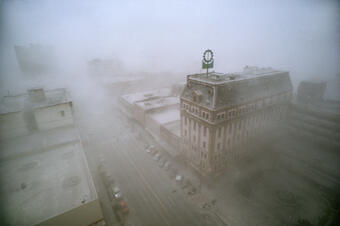What do you do when a volcano erupts? — Actions to take
Volcanic unrest is defined as the period of time when a volcano is showing unusual activity or is erupting.
Volcanic unrest and eruptions will be reported to the public through the Volcano Hazards Program websites and by the media.
Volcanic unrest is defined as the period of time when a volcano is showing unusual activity or is erupting. Unrest may last for months to years. During volcanic unrest, pay close attention to emergency plans and recommendations from officials. How YOU prepare will depend upon your location. You might be asked to shelter in place, or to evacuate. That is why it is important for residents and visitors to know their location relative to hazard zones. View the CVO Simplified Hazards Maps to learn more about hazard zones on volcanoes you live near or may visit.
When an Eruption is Underway
- Follow instructions for closures and evacuations. It might save your life.
- If you are in a lahar hazard zone and become aware of an oncoming lahar, get to high ground and then shelter in place. If your city or town has signed evacuation routes, follow them.
- If you are safe from lahars and at risk from ash fall hazards, shelter in place.
- Officials will update hazard zones and disseminate new information as the eruption develops. Watch and/or listen for additional information about emergency procedures.
- Do your part to remain safe, and help others in need.
If you are ON a volcano during an eruption:
- Move AWAY from hazard zones to improve your chances for safety.
- You may be exposed to falling ash and volcanic rocks (tephra), lava flows, lahars, toxic volcanic gases, and avalanches of hot rock and gas (pyroclastic flows).
- In confined spaces (caves or hollows) on the volcano, volcanic gases can concentrate and be very hazardous.
- Your route to safety might be cut off by lahars (volcanic mudflows). If lahars ARE a threat, STAY OFF VALLEY FLOORS AND OUT OF LOW-LYING AREAS.
- Pay attention to closure signs; they can save your life.
If you are NEAR, DOWNSTREAM or DOWNWIND of a volcano during an eruption:
You may be at risk from LAHARS (volcanic mudflows).
- Stay out of valleys and low lying areas that lead from the mountain.
- Consult the simplified hazards maps to determine whether you are in a lahar hazard zone.
- Prepare as you would for floods. You might need to evacuate people, pets, and valuables quickly.
- Become familiar with evacuation routes in your community.
- Listen carefully to official reports via emergency broadcasts, NOAA weather radio, or local notification systems such as 'reverse 911' or sirens.
- If officials detect a lahar seek high ground off the valley floor as quickly as possible, such as moving up a hillside. Then, shelter in place.
You may be at risk from VOLCANIC ASH FALL.

- Minimize your exposure to ash – improve chances for safety by providing shelter for people, pets, livestock, and machinery.
- Listen for up to date reports – ash fall might be a significant hazard or only a nuisance, depending upon eruption size, style, and duration.
- Advice for dealing with ash fall is similar to advice for dealing with dust storms.
- Tiny abrasive ash particles are easily inhaled and harmful; they can enter all but the most tightly sealed buildings and machinery.
- Ash particles can be small enough (less than 10 microns – similar to a dust particle) to be inhaled deeply into the lungs.
- People with existing respiratory difficulties have greater health risks. Keep extra medication and oxygen for people with existing respiratory difficulties.
- Carefully seal machinery with moving parts that may be exposed to ash.
- Adjust your lifestyle so that you can live safely and relatively comfortably with volcanic ash.
- DO NOT DRIVE, unless absolutely necessary; ash can damage the engine, filters, and exterior of your vehicle, and driving on ash-slickened roads with reduced visibility can be hazardous. Reduce driving speed.
- Extensive ash fall can cause power failures and disturb water, transportation, and communication systems. Wind and human activity can stir up fallen ash for weeks to years causing long-term disruption.
- Have survival and clean-up resources on hand such as dust masks, extra medications, plastic sheeting, and heavy-duty tape, so that you can live safely and with reasonable comfort during these interruptions.
- Avoid cleanup until ash has stopped falling. However, in some situations, immediate action may be required to prevent damage or loss of function to the building. Use extreme caution when cleaning to avoid falling from the structure you are cleaning - this is a major cause of causalities.


